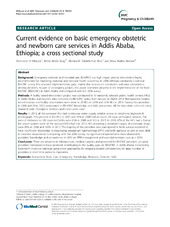| dc.contributor.author | Mirkuzie, Alemnesh Hailemariam | en_US |
| dc.contributor.author | Sisay, Mitike Molla | en_US |
| dc.contributor.author | Reta, Alemnesh Tekelebirhan | en_US |
| dc.contributor.author | Bedane, Mulu Muleta | en_US |
| dc.date.accessioned | 2014-10-23T11:54:42Z | |
| dc.date.available | 2014-10-23T11:54:42Z | |
| dc.date.issued | 2014-10-10 | eng |
| dc.identifier.issn | 1471-2393 | |
| dc.identifier.uri | https://hdl.handle.net/1956/8671 | |
| dc.description.abstract | Background: Emergency obstetric and neonatal care (EmONC) is a high impact priority intervention highly recommended for improving maternal and neonatal health outcomes. In 2008, Ethiopia conducted a national EmONC survey that revealed implementation gaps, mainly due to resource constraints and poor competence among providers. As part of an ongoing project, this paper examined progress in the implementation of the basic EmONC (BEmONC) in Addis Ababa and compared with the 2008 survey. Methods: A facility based intervention project was conducted in 10 randomly selected public health centers (HCs) in Addis Ababa and baseline data collected on BEmONC status from January to March 2013. Retrospective routine record reviews and facility observations were done in 29 HCs in 2008 and in10 HCs in 2013. Twenty-five providers in 2008 and 24 in 2013 participated in BEmONC knowledge and skills assessment. All the data were collected using standard tools. Descriptive statistics and t-tests were used. Results: In 2013, all the surveyed HCs had continuous water supply, reliable access to telephone, logbooks & phartograph. Fifty precent of the HCs in 2013 and 34% in 2008 had access to 24 hours ambulance services. The ratio of midwives to 100 expected births were 0.26 in 2008 and 10.3 in 2013. In 2008, 67% of the HCs had a formal fee waiver system while all the surveyed HCs had it in 2013. HCs reporting a consistent supply of uterotonic drugs were 85% in 2008 and 100% in 2013. The majority of the providers who participated in both surveys reported to have insufficient knowledge in diagnosing postpartum haemorrhage (PPH) and birth asphyxia as well as poor skills in neonatal resuscitation. Comparing with the 2008 survey, no significant improvements were observed in providers’ knowledge and competence in 2013 on PPH management and essential newborn care (p > 0.05). Conclusion: There are advances in infrastructure, medical supplies and personnel for EmONC provision, yet poor providers’ competences have persisted contributing to the quality gaps on BEmONC in Addis Ababa. Considering short-term in-service trainings using novel approaches for ensuring desired competences for large number of providers in short time period is imperative. | en_US |
| dc.language.iso | eng | eng |
| dc.publisher | BioMed Central | eng |
| dc.rights | Attribution CC BY | eng |
| dc.rights.uri | http://creativecommons.org/licenses/by/2.0 | eng |
| dc.subject | Assessment | eng |
| dc.subject | Basic | eng |
| dc.subject | Care | eng |
| dc.subject | Emergency | eng |
| dc.subject | Knowledge | eng |
| dc.subject | Neonatal | eng |
| dc.subject | Obstetric | eng |
| dc.subject | Skills | eng |
| dc.title | Current evidence on basic emergency obstetric and newborn care services in Addis Ababa, Ethiopia; a cross sectional study | en_US |
| dc.type | Peer reviewed | |
| dc.type | Journal article | |
| dc.date.updated | 2014-10-14T19:03:00Z | |
| dc.description.version | publishedVersion | en_US |
| dc.rights.holder | Copyright 2014 Mirkuzie et al.; licensee BioMed Central Ltd | |
| dc.rights.holder | Alemnesh H Mirkuzie et al.; licensee BioMed Central Ltd. | |
| dc.source.articlenumber | 354 | |
| dc.identifier.doi | https://doi.org/10.1186/1471-2393-14-354 | |
| dc.identifier.cristin | 1211420 | |
| dc.source.journal | BMC Pregnancy and Childbirth | |
| dc.source.40 | 14 | |

